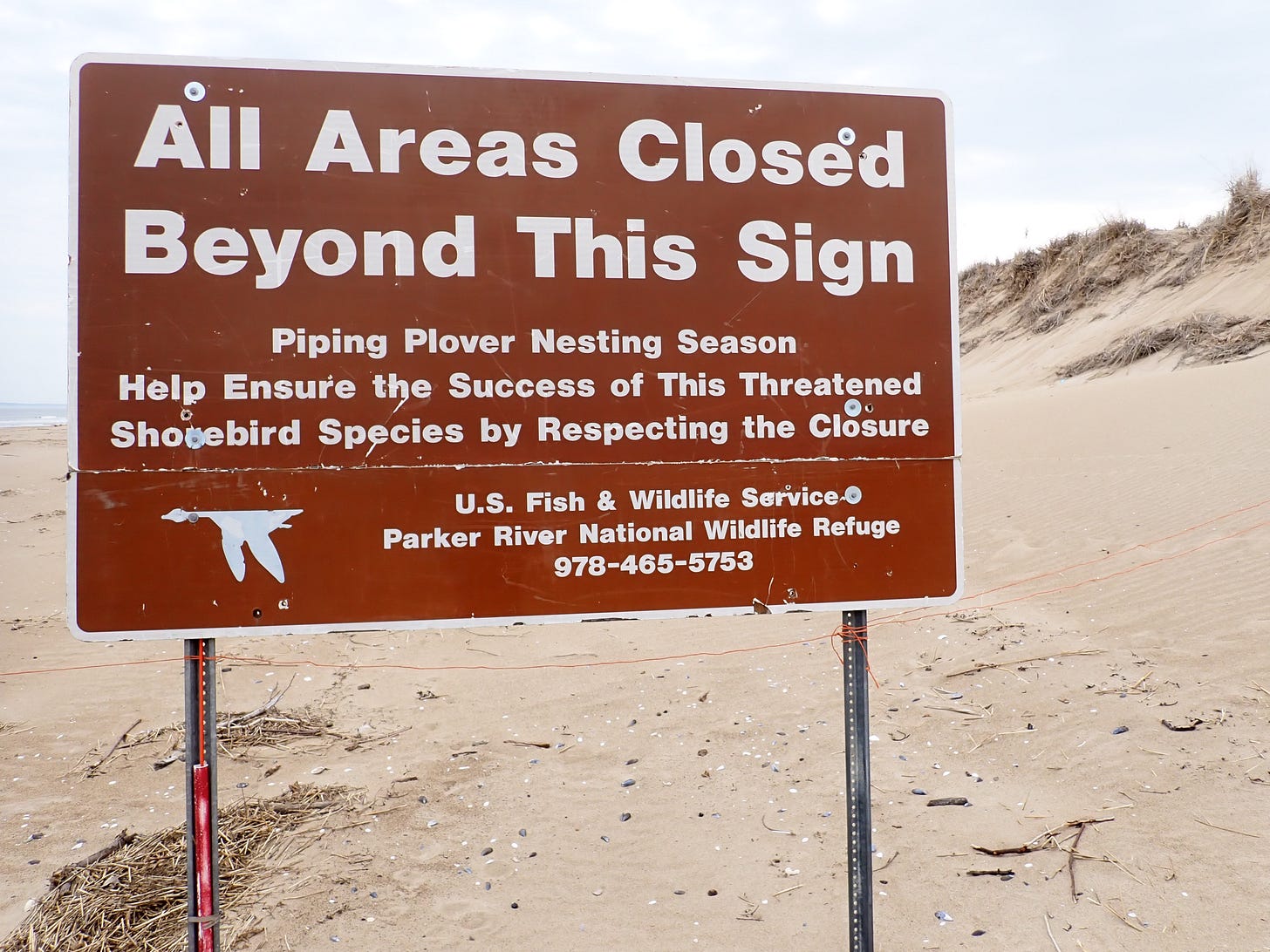Piping Plovers Taste Like Chicken
Not really, but the lack of access for humans in nesting areas gives one pause
By Roger Donegan
With our home situated between Lake Sunset and Lake Iroquois, in 1981 we bought a used 16-foot Keewaydin canoe. Partly for inspiration and partly for conservation we smoothed onto the bow a favorite decal advocating protection of sea birds, like Vermont’s once endangered loon. Little did any of us expect that theme would resonate for decades and come full circle recently in quirky relevance to an exhibit in Hinesburg’s back yard.
Piping plover is a small beach bird seen fast stepping on twig-like legs over sun dried sands down to the wet slope of shore made flat by wave action to forage.
Several types of plover are about 7.5 inches in length, have a stout orange bill and orange legs.
Well-known seashore refuges on the east coast and the Gulf of Mexico, such as Cape Cod, Assateague Island National Seashore (the Maryland home of the wild ponies), Cape Hatteras, and the Islands National Wildlife Refuge of southwestern Florida, have long provided the perfect habitat for this kind of plover.
As the bird became endangered, federal and state parks and refuges created different means to protect the habitat. One places a large rectangular cage over a piping plover nest once discovered which is no more obvious than a tiny speckled egg or two on a sandy landscape that blends with the terrain. The cage mesh is wide enough for plovers to come and go but screens out large predatory birds like gulls and four-footed scavengers.
“Bird Watching in Vermont” by Morin and Pfeifer (2002) has a side bar on one page titled “Finding Shore Birds in Vermont.” It lists the piping plover as an “accidental species” reportedly first seen in Bennington in 1908 and Burlington 1952. Now the piping plover can sometimes be seen on the sandy shores of Lake Champlain.
Killdeer, on the other hand, the largest plover at 10.5 inches in length and known as the only double-breasted band plover, is common in Vermont. A nesting killdeer will erupt on approach with a dramatic broken-wing display to draw attention away from a nest laid on bare ground or gravel such as dry riverbed.
The shore refuge with large colonies of piping plovers closest to home is the Parker River National Wildlife Refuge in Newburyport, Massachusetts, 32 miles north of Boston. It boasts a long stretch of sandy beach that is backstopped by dunes forming a barrier island protecting a marsh that still supports salt hay harvesting. In the state where Pilgrims first set foot one could say, tongue in cheek, the Parker River Refuge means of protecting piping plover habitat seem, well, Puritanical.
This past March, for instance, the approach to the boardwalk over the dunes to the ocean peppered visitors with official notices of approaching restrictions to protect the birds. One notice began with “This Beach is for the Birds” which should be taken literally.
A second sign read like a job posting: “Volunteer Plover Wardens Needed. Beginning in April, the entire refuge beach is closed to all public entry in order to provide undisturbed habitat for this (sic) federally threatened species. Plover Wardens are stationed at both the north and south ends of the Refuge’s 6.5 mile beach. The commitment is to 1-4 hour shifts, in morning, afternoon, or late afternoon.”
At the far end of the boardwalk were four larger signs – two official warnings alternated with two painted by school-aged children mounted on pilings forming the north boundary line right down to the water’s edge
Upon implementation, the people most impacted by the posted regulations are members of nearby communities who once had pedestrian access to the beach all summer long. So it took a moment some years ago for me to decipher a bumper sticker on a private vehicle in a parking lot which read “Piping Plover Taste like Chicken.” The bumper sticker apparently has caught on in a number of Atlantic coast beach communities. But, to reassure, the bird is hardly big enough to have a body to cook, never mind taste.
For those of you who want a closer view of a piping plover – at least a bird with near exact resemblance to a piping plover – head out on the Sherman Hollow Road and stop at the Birds of Vermont Museum that houses Bob Spear’s (1920-2014) 470 biologically accurate bird carvings. His teaching experience showed carvings to be superior to stuffed birds as educational tools. The ground floor diorama in the Wetlands Hall includes both common and rare species. Right there in front is a semi-palmated plover, the spitting image of a piping plover except for palmated, semi-webbed, toes. This carving is by Ingrid Rhind.
By the way, the restrictions and efforts to save the piping plover are working. In December 2024, the Massachusetts Audubon reported a 500 percent increase in nesting piping plover pairs (1,196) since the Coastal Waterbird Program began four decades ago.


